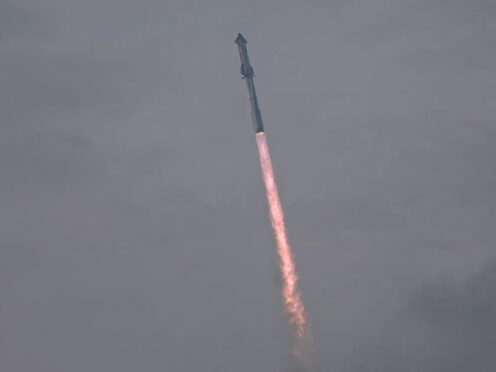
SpaceX came close to completing an hourlong test flight of its mega rocket on its third try on Thursday, but the spacecraft was lost as it descended back to Earth.
The company said it lost contact with the spacecraft as it neared its goal, a splashdown in the Indian Ocean, about an hour after lift-off from the southern tip of Texas near the Mexican border.
SpaceX’s Dan Huot said: “The ship has been lost. So no splashdown today.
“But again, it’s incredible to see how much further we got this time around.”
Starship will take humanity to Mars pic.twitter.com/BMBNI2mMKF
— Elon Musk (@elonmusk) March 14, 2024
The first two flights last year ended in explosions just minutes after lift-off.
Starship, the biggest and most powerful rocket ever built, soared from the southern tip of Texas near the Mexican border and headed out over the gulf. No people or satellites were on board.
Minutes later, the booster separated seamlessly from the spaceship and splashed down into the gulf.
Starship reached an altitude of about 145 miles (233 kilometres) as it coasted across the Atlantic and South Africa, before approaching the Indian Ocean.
But 49 minutes into the flight — with just 15 minutes remaining, all contact was lost and the spacecraft presumably broke apart.
At that point, it was 40 miles (65 kilometers) high and traveling around 16,000 mph (25,700 kph).
Starship is coasting in space pic.twitter.com/ZFUXMUkufW
— SpaceX (@SpaceX) March 14, 2024
The rocket and futuristic-looking spacecraft towers 121 metres (397 feet) high, easily exceeding Nasa’s past and present moon rockets.
SpaceX’s Elon Musk had just congratulated his team a little earlier.
“SpaceX has come a long way,” he said via X, formerly called Twitter.
The rocket company was founded exactly 22 years ago Thursday.
Nasa watched with keen interest: The space agency needs Starship to succeed in order to land astronauts on the moon in the next two or so years.
This new crop of moonwalkers — the first since last century’s Apollo programme — will descend to the lunar surface in a Starship, at least for the first couple times.
Nasa Administrator Bill Nelson quickly congratulated SpaceX on what he called a successful test flight as part of the space agency’s Artemis moon-landing programme.
Congrats to @SpaceX on a successful test flight! Starship has soared into the heavens. Together, we are making great strides through Artemis to return humanity to the Moon—then look onward to Mars. https://t.co/VXq8Vp1sAc
— Bill Nelson (@SenBillNelson) March 14, 2024
The Federal Aviation Administration reviewed all the corrections made to Starship, before signing off on Thursday’s launch.
The FAA said after the flight that it would again investigate what happened.
Initially, SpaceX plans to use the mammoth rockets to launch the company’s Starlink internet satellites, as well as other spacecraft.
Test pilots would follow to orbit, before the company flies wealthy clients around the moon and back. Musk considers the moon a stepping stone to Mars, his ultimate quest.
Nasa is insisting that an empty Starship land successfully on the moon, before future moonwalkers climb aboard.
The space agency is targeting the end of 2026 for the first moon landing crew under the Artemis programme, named after the mythological twin sister of Apollo.

Enjoy the convenience of having The Sunday Post delivered as a digital ePaper straight to your smartphone, tablet or computer.
Subscribe for only £5.49 a month and enjoy all the benefits of the printed paper as a digital replica.
Subscribe